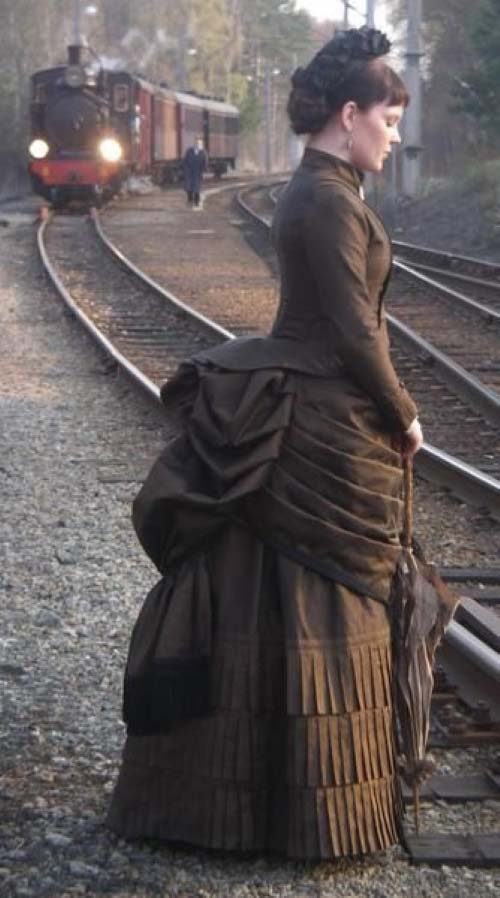Costume Designer
“Without foundation there is no fashion”
Dior
An interview with Geoffrey W Duffield .DPhil.
Costume designer for television, film, theatre, ballet and opera.
How did you start with costume design, specifically in corsetry?
I always had an interest in fashion, I applied to various colleges and was accepted by the London College of Fashion. I found corsetry came naturally to me as it was all mathematics and drawing board work, a transferable skill I had and I did not want to go into commercial fashion.
What did you do before designing costumes?
Originally I was a Merchant Navy Officer. Joining Birch Bros Shipping as an apprentice deck officer. At 17 I obtained my certificate as 1st Officer Deepsea. I was the only Merchant Navy Officer who read Vogue Magazine to pass the time.


How long have you been designing costumes?
I started in 1978 and formed a company – Button, Boot and Spatterdash
Along with 3 ladies, Miss Robyn Le Jeune, Miss Charlotte Brill and Miss Amanda Payne. Today the company is known as Sarah P Goodrich and Co.
Is Corsetry your specialty?
Yes the firm became known for our corsets, shoes and millinery for film, theatre, opera and ballet.
How did you get involved with film and theatre costume design?
Our big break came with a BBC series called Lilly Langtree, where Miss Francisca Annis played the lead role. I made a Spoon Busk 1890s corset and a bustle for a formal gown for her.
Where do you get your ideas and influences from?
Research, research, research.
A lot of ideas are from research into social history depending on the project, getting the fashion right.
What is your favourite element of the job?
All the work is stimulating, from designing a costume- through to wardrobe work in live theatre ‘the quick change’ – where you get the rush of excitement.
For example the musical Mame – she comes off stage and it’s hat-wig-dress-shoes-jewellery-radio mic changes all in thirty seconds and back on stage.
Can you give a run down on some of the projects you have been involved with over the years.
Films – Catherine the Great, Orlando, various Bond films, Onedin Line,
House of Mirth, The Danish Girl, The Bostonians, Ladies Paradise to name a few.
Series – Tipping the Velvet, Crimson Petal, Sherlock Holmes, Enola Holmes.
I have worked for Prima Ballerinas in the Kirov Ballet Company- St Petersburg, Bolshoi Ballet -Moscow.
The Greek National Opera, La Scala -in Milan, Salzburg, Vienna
and more.
I have done work for the Rolling Stones, Michael Ball, Gillian Anderson still do work with her.
What are you working on at the moment?
At present everything has slowed right down because of Covid and has interrupted the training of the actors working on the film, called the Bolton and Parks Scandal due to be released in 2021-2022.
A controversial film about transexual Thomas Ernest Bolton and homosexual Frederick William Park set in Victorian times.
Bolton lived with Lord Clinton and presented “herself” as Lady Clinton – her corset maker and dress maker of the time accepted the fact.
It’s not just “ plonk on a frock”, training 18 year old actors to be 14 years old and young ladies of the 1880s keeping them in the right mindset has lots of trials and tribulations.
How do you see the future of this industry?
Business is hard as you are out of work more than you are in work.
If a door opens you rush in, but you don’t know what is behind the door and no idea when a door will shut.
The future for Sarah P Goodrich and Co we are now based in France.
There is work in the pipeline for television and film and the opera, ballet and live theatre but Covid has brought everything to a standstill.
Do Corsets have a place in todays’ fashion? What are your thoughts?
“Shapes are made – shapes do not just happen”
Think about that a little – say you are wearing a straight skirt,
Do you really need to look like you are hiding a football under your skirt or do you have a flat tummy, do you see the outline of your knickers or wear the corset. This is where corsets and shapewear have a place.
In the 1850s there was great expansion with the industrial revolution so fashion and skirts became wider as did corsets, in the 1880s-90s we had a recession, skirts became tighter and so did corsets.
In the late 1940s-50s we went back to a more feminine shape, corsets and the hourglass figure was back. It shows corsets do have a place in fashion and fashion reflects what is going on in society.
To me it’s all about shape and classic style.
What advice would you give to your younger self?
When starting out you have no idea where life is going to lead you, enjoy every moment and do things you like doing. If it becomes “Oh gosh it’s Wednesday and it’s all downhill” then stop doing that and find something else.
“To embrace life – you must embrace your own mortality”
Thank you for your time
It has been a pleasure to speak to you Geoffrey W Duffield .DPhil, Costume designer extraordinaire.

